| Stein Collectors
International |
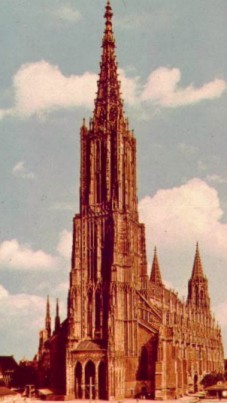 |
| Thanks to Jeffrey Jarrett and his website about Ulm Germany,
for this image of the Ulm Munster. |
~All About Ulm~
Die Ulmer Spitze, or Sparrow of Ulm
The Flying Tailor of Ulm
by Walt Vogdes
This article draws from one which appeared in the March 1992 issue of
Prosit, plus material excerpted from the web site created by the Tourist Bureau of Ulm/Neu-Ulm. Ulm is located just
across the Danube from Bavaria in the state of Baden Wuertemberg, about an hour
and a half drive west of Munich, and 45 minutes north of Bad Schussenried, site
of the Beer Stein Museum.
The city of Ulm, located on the Danube, possesses one of the most beautiful
medieval cathedrals in Germany, a 14th century Gothic structure whose 160m
(525-foot) tower is the highest church tower in the world. By comparison, the
cathedral at Strasbourg is a mere 142m. The tower was built in two stages - the
lower three stories constructed over the course of a hundred years (1392-1492),
with the upper part of the tower being completed between 1885 and 1890 (smack in
the middle of the Golden Age of beer steins).
|
The Legend of Die Ulmer Spitze
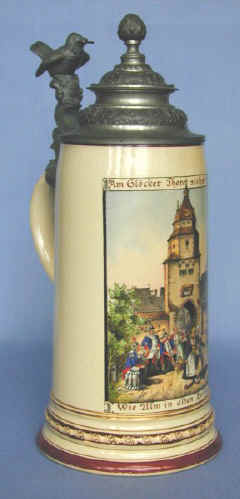
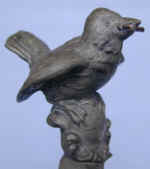
The Ulmer Spitze as thumblift, with twig in mouth, prepared
to give lessons. |
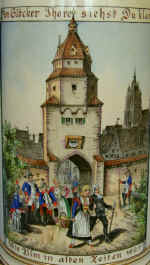
This pottery stein shows the Ulm city gate with the cathedral
in the background. |
According to legend, construction of the spire of the Ulm Munster was
halted while only halfway completed when a wagon carrying a large wooden beam -
loaded sideways - arrived at the narrow city gate. After contemplating how best
to proceed, the mayor of Ulm gave the order to tear down part of the city wall,
but before the order was carried our, a sparrow-like bird was observed
maneuvering a long twig into its nest - lengthwise! Following the lead of the
sparrow, the beam was turned, the wagon passed through the narrow gate, work was
resumed, the cathedral was completed, and the legend of the Ulmer Sp�tze
was born.
As a symbol of the city, the wren or sparrow of Ulm frequently appears on beer
steins. This is especially true of regimental steins for units which were
garrisoned in Ulm, where the wren with a twig in its mouth is the standard
thumblift.
The following poem gives a light-hearted look at the legend:
T'was many, many years ago
when the following happened in Ulm, you know!
For all the buildings in the town
One had to bring the timber down.
It turned out to be the people's fate,
they couldn't get the timber through the gate.
After much thinking they reached the conclusion,
to lay it sideways would be the solution.
But the gate was too narrow, the beams were too wide;
the city surveyor just stood there and cried.
They talked and discussed without abating,
but the problem became only more frustrating.
Even the magistrate, a man so wise
could find in this case no helpful advice.
He looked in books, he searched all around,
but nowhere was such a case to be found.
Even the mayor himself was perplexed,
and had no idea what to do next;
he who always knows everything best,
became quite irate with this difficult test.
The embarrassment continued for hours, my word,
and then lo and behold! Something occurred:
One bright man a sparrow did spy
building his nest in the tower up high.
In his mouth, sideways, he carried a straw,
which he laid down in front of his tiny nest door,
and then with his beak and this is no jest,
he turned it around to point to the nest.
"Well, what do you know!" Laughed the man with a roar,
"That's how to get the beam trough the door."
So they tried and it worked, they now had it beat,
thanks to the sparrow and his marvelous feat.
They might still be standing there now at their wall,
with their cart full of timber loaded and all,
or might without that sparrow's knowledge
have had to sell it or have it demolished.
In the sparrow's honor, you can see at this hour,
his picture in stone near the cathedral tower;
and Ulm's favorite dish, from then until now
is named after the sparrow who showed them how!
A slightly different version of this legend is given by John Harrell in his
1979 book, Regimental Steins, page 73. But the important part of both
versions is that the Ulmer Spitze showed how the long beams could be
maneuvered into position, allowing completion of the spire.
The stein shown below provides transition to a second story about Ulm that
of Die Fliegende Schneider, or Flying Tailor. We see the now familiar
sparrow in the left scene, the crest of the city of Ulm on the Danube in the
center, and the central character of this next story to the right.
The Flying Tailor of Ulm
Albrecht Ludwig Berblinger, the so-called "Tailor of Ulm"
(1770-1829), constructed a kind of hang-glider in the years 1810/11. He dreamed
of gliding through the air like a bird and became quite famous. On 31 May 1811
Berblinger attempted to fly from the walls of the Eagle's Bastion ("Adlerbastei")
over the river Danube. The King of Wurttemberg was present as a spectator on
that day but the "Tailor of Ulm" failed in his attempt. He fell into
the river because the thermal conditions above the cold Danube would not provide
the necessary updarft.
In 1986 there came proof that Berblinger's construction could fly: a man was
able to cross the Danube with a reconstruction of the original hang-glider.
Less known is that the fussy Berblinger also constructed an "artificial
foot-machine" which was used for amputations of a foot and lower leg.
Nevertheless, the Bavarian king refused his request to advertise this new
invention in public. Berblinger was acknowledged as a good tailor and in 1812 he
began his job as a regimental tailor in Ulm. On 28 January 1829 Albrecht Ludwig
Berblinger died at the hospital at the age of 58 years. The official cause was
consumption. His last resting-place is unknown because he was buried somewhere
as a poor man.
We complete our look at Ulm with another stein, this one in porcelain with a
fine hand-painted scene. Again we see both of the heroes of these tales, the Schneider
to the left, scissors around his neck and wings raised, and the Ulmer Sp�tze
to the right, with stick in its mouth, still giving lessons in building.
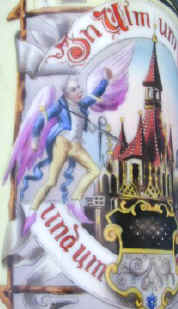 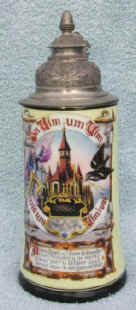 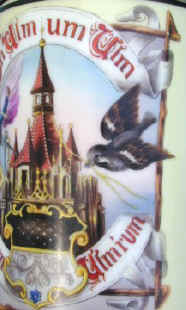 |
Stein Collectors
International 1996-2014
All rights reserved.
|
|
|